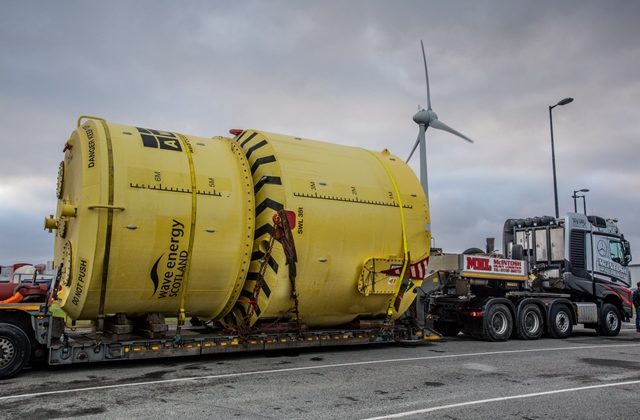
A new 16 kW wave-energy converter developed by Inverness-based AWS Ocean Energy has arrived in Orkney ahead of its imminent deployment at the Scapa Flow test site run by the European Marine Energy Centre (EMEC).
The seven-metre-high, four-metre-diameter Archimedes Waveswing travelled to Orkney by ferry following a period of dry testing undertaken by the AWS engineering team at Muir of Ord.
When deployed, the device will be moored to the seabed on a single tension tether, where it will generate energy by reacting to changes in pressure caused by passing waves. The subsea location, together with an ability to winch low in the water column, will enable the device to continue to operate even during rough sea conditions. The Waveswing has been designed to react to long ocean-swell waves as well as short, wind-driven seas, increasing its energy capture.
‘This is another major step forward in the development programme, underlining our confidence that the Waveswing really is the best prospect for practical, affordable wave power,’ said Simon Grey, AWS Ocean Energy’s CEO. ‘Our current Waveswing design focuses on remote-power applications, such as powering subsea oilfield assets and oceanographic monitoring; however, the device is suitable for integration into submerged platforms and can be scaled to more than 500 kW per unit. AWS expects to develop platforms hosting up to 20 units with a potential capacity of 10 MW per platform.
‘Achieving power outputs comparable with offshore wind units is critical to driving down the cost of energy and ensuring that operation and maintenance is practicable in the hostile marine environment,’ he continued.
“Real sea deployment is a vital step in proving performance, reliability and survivability of these devices,’ said Neil Kermode, the EMEC’s managing director. ‘We know that prototype testing at sea is really valuable to technology developers to check how a technology and its components work and react in the environment prior to scaling up. We are looking forward to helping the team as they prove how to install, operate and maintain their exciting machine in Orkney’s harsh conditions.’


